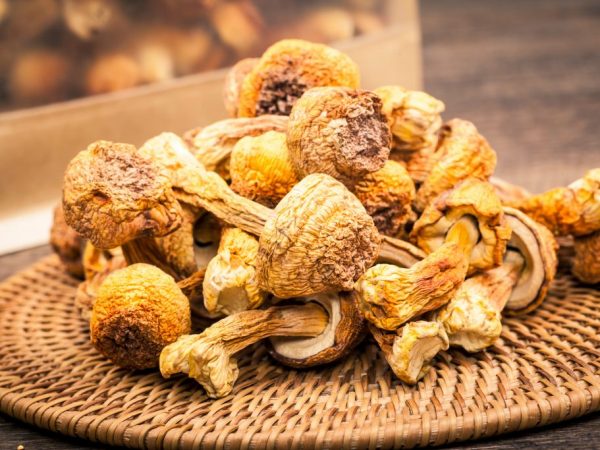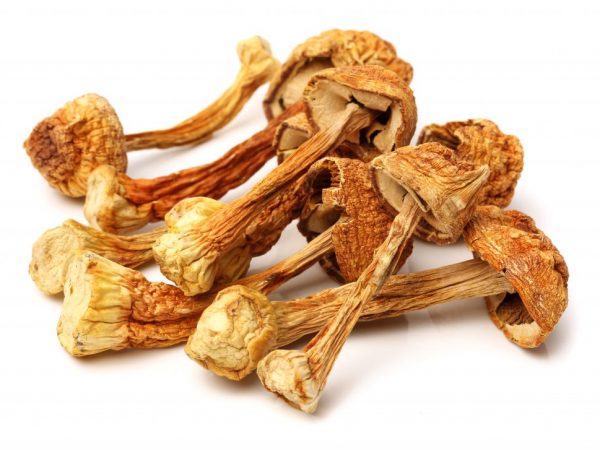Brazilian agaric mushroom
The Brazilian agaric mushroom belongs to the Champignon family, or Agaricaceae, and belongs to the Agaricus genus. The genus includes about 30 species, but only it is characterized by medicinal properties.

Brazilian agaric mushroom
Botanical characteristic
This species is edible. In a young agaric mushroom, the cap has a cylindrical or conical flattened shape, which then becomes prostrate, a bulge forms in the center. The diameter of the mushroom cap is 5–18 cm, but sometimes there are “giants” with the diameter of the cap reaching 30 cm.
Irina Selyutina (Biologist):
Wild agaric mushrooms are also called "button mushrooms" because their caps barely peck out of the ground and are practically invisible among the thickets of grass. The hat appears as a small button. At the beginning of its development, it is snow-white, then it becomes pink, purple and black. Locals who in Brazil collected agarics in the wild used dogs that were trained to smell mushrooms, which is quite characteristic. Just like in France, dogs were trained to search for truffles. Isn't it how amazing life is? Different countries, different mushrooms, but their searches are similar.
These edible mushrooms have a very unusual taste - at the same time, it is spicy and sweet and sour. The inhabitants of the Brazilian village, near which the almond mushroom was first described, used it in powder form to add to sauces, various meat dishes and in the manufacture of potions.
The surface of a young specimen is covered with a silky fibrous bloom. The cap of an adult organism has a coating of small scales. The color ranges from white to reddish brown. As they grow, the edges of the caps fall apart.
Agaric from Brazil has other names - almond, Brazilian mushroom, mushroom of life, button mushroom, princess of mushrooms, etc.
The mushroom pulp is white, soft. Has a sweetish taste and an almond or aniseed smell. The mushroom leg is 6–12 cm high, 1.0–1.5 cm thick, has the shape of a bulb, expands towards the base. At the initial stage, it is characterized by a dense and solid structure, then it becomes hollow. The peduncle with pubescence at the base is scaly.
The Brazilian mushroom was discovered and described only in 1965 by the American mycologist Murril.
The edges of the cap in young specimens are connected to the leg by means of a blanket. Subsequently, its integrity is destroyed, forming a two-layer smooth curved ring directed towards the mushroom stem.
Spread
The mushroom described by Murril, after being discovered in Brazil, was found in the northeastern United States and Canada, and a little later in Hawaii, the Philippines, Britain, Brazil and the Netherlands.
Grows in small colonies or singly, preferring forest litter with enriched soil. Grown in artificial conditions in laboratories.It is widespread in China, where it is grown from mycelium on substrate soils in darkened rooms throughout the entire calendar year.
Chemical composition
The chemical composition of the almond mushroom contains:
- benzaldehyde, benzyl alcohol, benzonitrile and methyl benzoate, which provide its specific smell;
- polysaccharides beta-glucans, which carry the function of penicillin (antibiotic);
- pyroglutamate - an acid with tumor blocking properties;
- steroids that affect the cellular composition of carcinoma and stop the process of tumor growth;
- provitamin D3;
- lipids;
- linoleic acid.
Scope of application

The mushroom has found its use in medicine
The main area of application of Brazilian agaric is pharmacology.
General therapy
Agaric Brazilian has the following properties:
- prevents radiation damage to cells;
- participates in regeneration processes in violation of the structure and functions of liver cells, improving its functions, maintaining the values of bilirubin and prothrombin, bile acid and iron-containing protein, restores the cellular composition in hepatitis, normalizes enzymes, acts as a stimulant for hemocytes;
- lowers the percentage of sugar in the blood, increasing the level of insulin resistance, prevents the development of diabetes;
- normalizes blood pressure;
- regulates the level of cholesterol in the blood, preventing the development of atherosclerosis;
- neutralizes the activity of allergic processes, helping with dermatitis;
- suppresses fungal pathogenic flora, contributing to the treatment of fungal infections;
- normalizes the immune system, maintaining homeostasis;
- acts as a weight loss stimulant, removing cholesterol and cleansing the body of toxins, promotes weight loss.
With oncology
The medicinal properties of the Brazilian agaric mushroom are aimed at combating malignant tumors, including sarcoma, melanoma and leukemia, as well as treating benign formations, including polyps, papillomas, adenomas and fibroids. Preparations with almond fungus effectively affect neoplasms in the last stages in oncology, when ascites develops and lymphostasis begins. Effectively removes metabolic products of a malignant tumor in a state of necrosis.
Conclusion
The Brazilian agaric mushroom is an edible champignon. It benefits human health and is used in general therapy and prevention. The medicinal properties of almond champignon are widely used in the fight against oncology.



